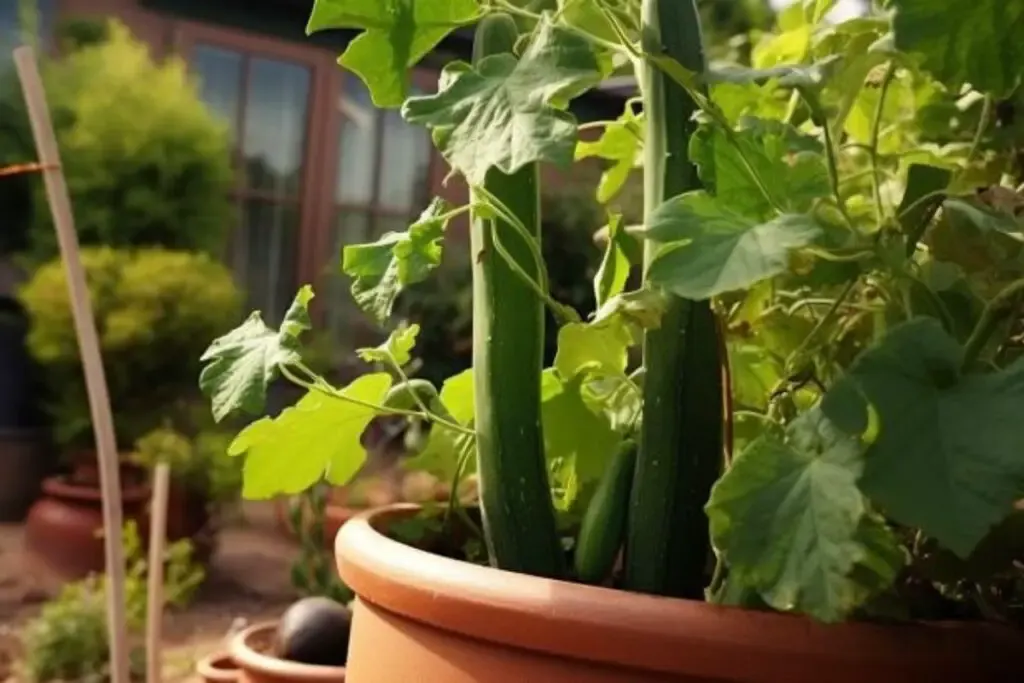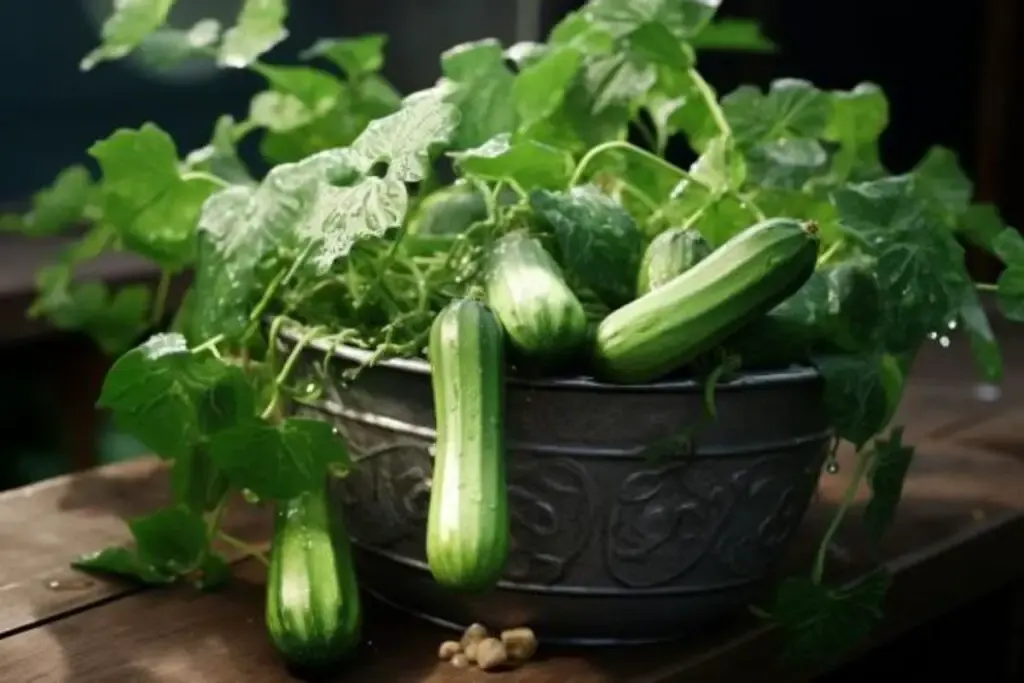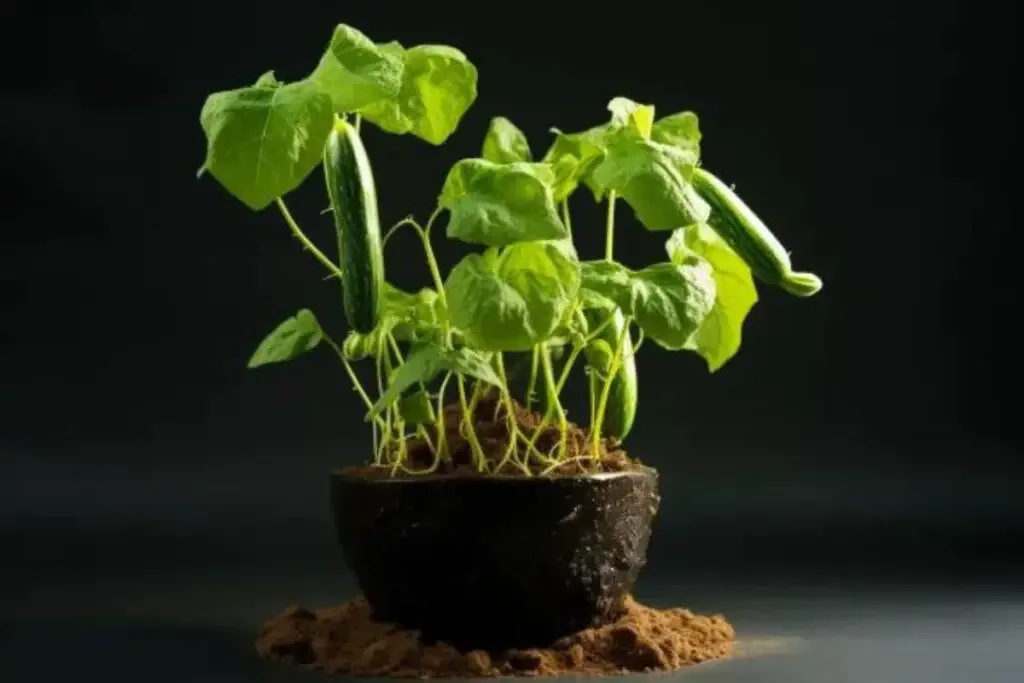Gardening enthusiasts often look to the versatility and beauty of lush green plants to enhance their outdoor space, and what better way to add both form and function than by growing cucumbers in pots?
Whether you’re an urban gardener with a balcony or a homeowner with a sprawling backyard, cultivating cucumbers in containers can be a rewarding endeavor.
Not only do you get to enjoy the refreshing crunch of home-grown cucumbers, but you also have the joy of watching your plants thrive in their cozy, controlled environments.
As an expert gardening blogger, I’ve seen firsthand how a few pots bursting with life can transform a space—and your culinary options.
So, let’s dive in and explore the art of growing cucumbers in pots, ensuring that even a novice gardener can feel like a seasoned green thumb!
Does Cucumbers Grow Well in Pots?
Absolutely! Cucumbers are well-suited to container gardening. These vigorous plants have roots that spread out rather than deep, making them perfect candidates for pot life.
The key to successful cucumber cultivation in pots lies in selecting the right variety, and pot size, and maintaining diligent care, including consistent watering and feeding.
Growing cucumbers in pots also has its unique set of advantages. It allows for better control of the growing conditions, prevents most soil-borne diseases, and can significantly reduce the risk of pest infestations. Moreover, it makes the perfect option for those seeking to make the most of limited space.
Best Cucumber Varieties for Pots
When choosing cucumber varieties for pots, it’s important to consider the size and growth habits of the plant. Bush varieties or compact vine types are ideal since they’re bred to take up less space and still produce a bountiful crop.
Here are some top picks that I’ve found to be especially well-suited for container gardening.
1. Bush Slicer

The Bush Slicer cucumber is a favorite among container gardeners for its compact growth and excellent production.
This variety produces abundantly, offering up crisp, medium-sized cucumbers perfect for fresh eating. What’s great about Bush Slicer is that it doesn’t require a trellis, making it a superb choice for pots on patios or decks where space is at a premium.
2. Salad Bush

Salad Bush is another variety that’s ideally suited for pot culture. It’s a hybrid that was specifically developed for container growing, featuring short vines and producing early.
The cucumbers themselves are flavorful and ideal for salads—as the name suggests. This variety is also resistant to common cucumber diseases, which is a big plus when you’re aiming for a hassle-free gardening experience.
3. Spacemaster

Spacemaster cucumbers are a tried and true variety that thrives in the confined space of a pot. These plants have a very compact vine, making them an ideal choice for small gardens and balconies.
Despite their small stature, they produce a generous yield of classic cucumbers that are as tasty as they are versatile. It’s a reliable variety that’s been a mainstay in my container gardening for years and for a good reason.
How to Grow and Care For Cucumbers in Pots
Growing cucumbers in pots can be just as rewarding as tending to an in-ground garden, if not more so. The key to success lies in understanding the specific needs of potted cucumber plants and providing them with the right conditions and care.
Let’s walk through the essentials to ensure your potted cucumbers are not just surviving, but thriving.
Planting
Planting cucumbers in pots begins with timing. In general, you’ll want to plant your cucumbers after the last spring frost date for your area. Cucumbers are warm-weather friends and can be quite sensitive to frost.
I recommend starting seeds indoors about 3-4 weeks before you plan to move them outside. When transferring the seedlings to pots, handle them gently, especially the roots, to avoid transplant shock which can set them back a few days.
Pot Size
When it comes to pot size, bigger is often better. A large pot will accommodate the cucumber’s roots and provide the necessary space for growth and access to moisture and nutrients.
Typically, a pot that is at least 12 inches deep and wide is sufficient for one cucumber plant. If you’re using a trellis or growing a variety with more sprawling habits, you might want to size up to ensure stability.
Light
Cucumbers are sun worshippers and require a minimum of 6 to 8 hours of direct sunlight per day. If you’re placing pots on a balcony or patio, make sure they get plenty of light without being shaded by other plants or structures.
The more sunlight they receive, the better they’ll produce.
Soil
A well-draining, nutrient-rich potting mix is crucial for cucumbers. They don’t like “wet feet,” so soil that retains moisture without becoming waterlogged is ideal.
I like to add a bit of compost or well-rotted manure to the mix for added nutrients and to improve soil structure and moisture retention.
Water
Consistent watering is critical for cucumbers, especially when they’re grown in pots. They need a steady supply of water to avoid stress, but overwatering can be just as harmful as under-watering. Aim to keep the soil moist but not soggy, and be consistent.
Watering in the morning is best as it allows for moisture to be used throughout the day and helps prevent mildew and other moisture-related issues.
Temperature and Humidity
Cucumbers thrive in warm conditions with daytime temperatures between 70-85°F (21-29°C) and night temperatures not dipping below 60°F (16°C). They can handle a bit of humidity but watch out for signs of mildew or fungus if conditions are too damp.
Fertilizer
Feed your cucumbers a balanced, water-soluble fertilizer every two weeks, or use a slow-release fertilizer as directed. Cucumbers are heavy feeders when they start producing fruit, so don’t neglect this step.
Organic options like fish emulsion or compost tea are also excellent choices for providing nutrients to your cucumbers throughout the growing season.
Pruning Potted Cucumbers
Pruning might not be the first thing that comes to mind when you think of cucumbers, but it’s a practice that can significantly enhance the health and productivity of your plants.
Pruning potted cucumbers helps to improve air circulation, reduce disease, and direct the plant’s energy to the most promising fruits.
To prune like a pro, you’ll want to start by removing any dead or yellowing leaves, which can be a hotbed for disease. Then, take a look at the vines. Cucumber plants develop suckers similar to tomato plants, and these can be pruned to maintain vigor.
However, be cautious not to overdo it; cucumbers need a certain amount of foliage to protect the fruit from sunscald.
Remove any flowers or fruits from the lower part of the plant to encourage growth upward and ensure the fruits don’t touch the soil (which isn’t much of an issue in pots but is still a good practice). Also, pinching off the tips of the vines can encourage branching, which may be beneficial for bush varieties.
Regular pruning sessions are key; a weekly check should suffice to nip any unnecessary growth in the bud (sometimes quite literally!).
Overwintering
Most cucumber varieties are grown as annuals, which means they won’t survive the winter and need to be replanted each year.
However, if you live in an area with mild winters, or if you want to attempt to overwinter a particularly productive or special plant indoors, there are a few strategies you can employ.
If the cucumbers are in portable pots, you can move them to a protected area like a garage or indoors before the first frost. The goal is to keep the plants in a state of dormancy, which means cool temperatures (but not freezing) and reduced water.
For overwintering indoors, choose a spot with good air circulation and some light, but don’t expect much in the way of growth; this is about survival, not productivity. Cut back on watering to prevent root rot in the cooler, lower-light conditions.
Remember, though, that cucumbers are usually happiest when grown fresh each season. Overwintering can be a fun experiment, but it’s not typically part of the cucumber lifecycle.
Keep in mind these tips and you’ll be well on your way to enjoying crisp cucumbers from your potted garden for seasons to come!

